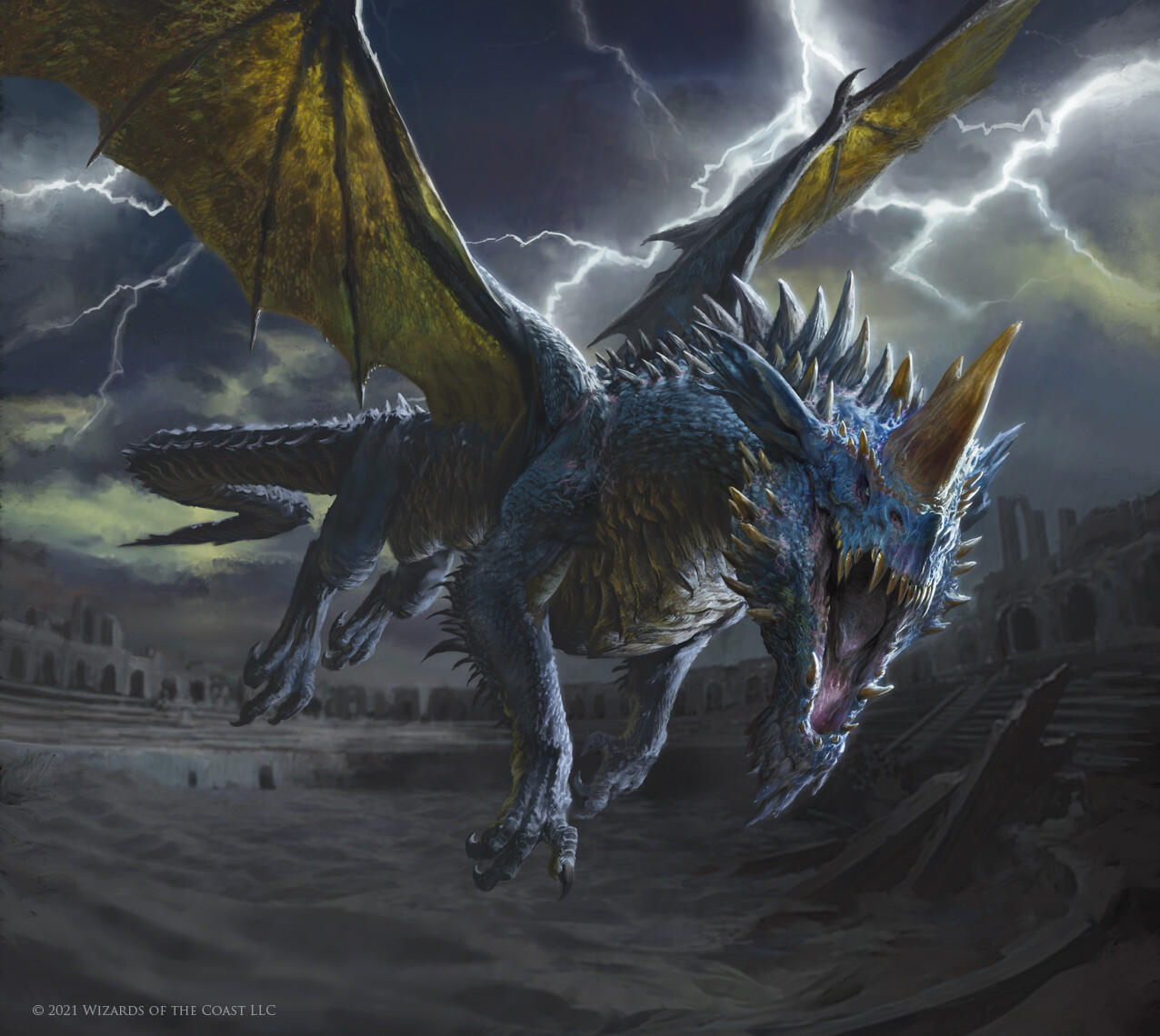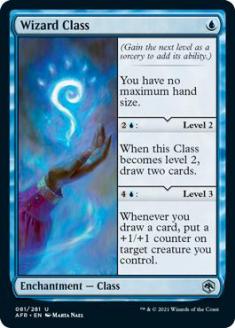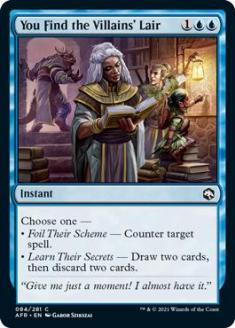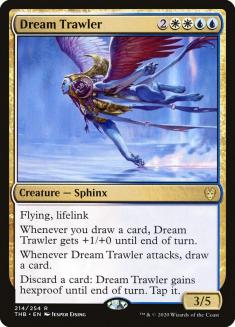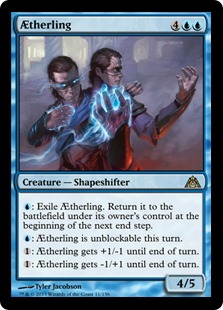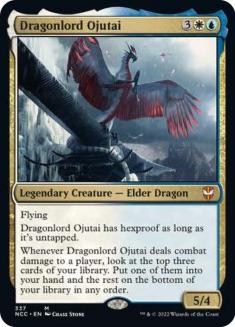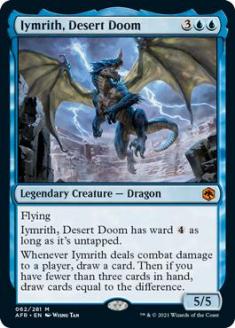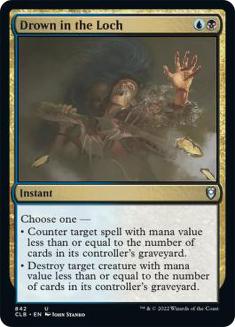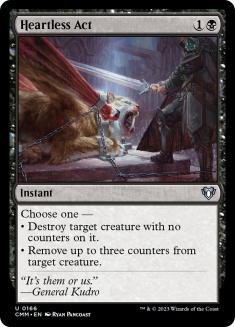I have made quite a few decks since my competitive play debut in 2003. From the start I went against the grain, for better or for worse, crafting decks that perfectly fit my control playstyle. Occasionally a combo deck would spawn from the Esper Professor’s lab, but my devotion rests strongly in the control cabal. We’re looking at another preview season here, with Adventures in Forgotten Realms a few weeks away from release. And as an avid Dungeons & Dragons fan, the flavor of this set is off the chart.
Understanding the connections between the Magic cards of this set and the D&D world has been a pleasure thus far. The only let down that I have faced is the lack of control elements being brought forward, especially with such strong showings in the last few Standard sets. It looked like the bar was finally being raised, with control cards at a competitive power level as its creature-based colleagues. Even in the recently released Modern-only set, control has a dominant showing with no shortage of format staples entering the fray. The direction has been promising, which has made Adventures in Forgotten Realms a slight let down so far.
I’m not expecting Counterspell in Standard, or Teferi, Hero of Dominaria to return, but we need some assistance to resuscitate the control archetypes. The format is as stale as it gets, with Sultai Ramp (Yorion) in a dominant position, while its competition rests in various aggro and a goofy Jeskai Cycling deck. I’ve had fun battling in Historic, Modern, and even Pioneer as of late, but Standard has been a chore to get games in. The only way to put a dent in this drag of a format is to either fight fire with fire or take the loss and begin to drop the power level down for the future.
The latter is what WotC decided, made glaringly obvious from the previews we have already seen. The power level of Standard will drop; however, we must wait quite a while for the rotation to occur. Although I’ve been disappointed by the lack of control cards previewed, I’m happy to see the creatures significantly weakened for future gameplay. There is plenty of time, in this set and sets arriving later in the year, to provide control strong disruption to become competitively relevant once again. A Cancel with a Faithless Looting element is not going to get the job done, even in a future format that puts creatures in a weakened state.
The days of missing a key control element and still finding success in Standard are over. If the disruption, card advantage, and win conditions are not firing on all cylinders, the control mage is going to have a bad time. When I look at Standard, now or contemplating a future version, I see decent options in most of those categories. The sweepers are strong, the card draw is adequate, and the removal (especially black-based) is outstanding. Where control is falling short is the resilience of our enemies’ threats and the weakness of a true, control win condition.
Planeswalkers have always been my go-to, especially options as strong as Teferi, Hero of Dominaria. If the planeswalker can win the game and assist in one of the other control jobs out there, it ‘s a slam dunk for the home team. We’re lacking such a leader and have nothing even close to it. I’ve tried each planeswalker available to the traditional control colors without success. Ugin, the Spirit Dragon is a house against most decks when it resolves; however it costs eight mana. The same flaw hits home for Professor Onyx, restricted by its high mana cost. The cost of these planeswalkers weaken their reliability as a win condition. Looking outside of my favorite card type, I enlisted the service of each creature you can think of, the most promising being Dream Trawler.
Dream Trawler is still a stud for control, essentially locking out ill-equipped opponents upon its resolution. I have covered the pros of this creature in detail over the last year, but the negatives are keeping it out of contention. It’s an Azorius spell, with a restrictive mana cost. Not only does it cost double of each, but it also requires six mana to produce. With decks packing Mystical Dispute, this isn’t the easiest task to complete when trying to stabilize the battlefield. It comes at the worst time against Sultai Ramp, as tapping out the turn before they hit seven mana is a death sentence. I’m not opposed to having a powerful creature like this steer the ship, but it has been difficult to find a winning configuration with my Azorius friend here.
Creatures have led control to success in previous Standard formats. I found much of my success with this, battling in premier event after premier event with Aetherling, showing the world what control can do once it stabilizes with a powerful threat. The show did not stop there for me, as I crafted Esper Dragons in the very first tournament it was legal in, narrowly missing Top 8 in its debut. Being the first to toss some Dragons together was rough, since I built it in a similar fashion to my control decks of old. The Dragons were legends, prompting me to skimp on the total count of each. With only two copies of Dragonlord Ojutai and Dragonlord Silumgar, my deck was far from optimized.
I have received a second chance in deckbuilding, with the effective return of Dragonlord Ojutai. Iymrith, Desert Doom is nearly a spitting image, signaling a return of creature-based win conditions for multiple control archetypes. Unlike Dragonlord Ojutai, Iymrith only requires blue mana, making it a universal option for control decks. It’s an exciting proposition to have a blue-only win condition, just like the days of Aetherling long ago. Even though I have differed to Esper Control, often by default, the option to play a control deck without white is nice.
The black removal in Standard is still amazing and makes Iymrith a likely star in Dimir Control. The reason to use white is minimal these days, even with Elspeth Conquers Death and Doomskar. Black has better all-around disruption and creates cleaner, more reactive control gameplay. The mana requirement of Iymrith is the strongest aspect of the card at first glance, even though the other attributes are far more exciting.
Iymrith has Ward 4 while it’s untapped, effectively making it hexproof in that state. In the late-game there will be moments of weakness for our blue Dragon, with the opponent having enough excess mana to take it out the turn it’s summoned. The drawback is that the opponent will must use their entire turn to do so, or risk failing if they wait for our turn to combat it. Dragonlord Ojutai never gave the option to the opponent, making it slightly better in that regard, but the difference may be negligible in practice.
Iymrith’s power/toughness being five and its flying makes for a deadly threat the moment it resolves. The clock is a short four turns, especially with the traditional black and blue disruption protecting it along the way. Killing the creatures in the path of Iymrith is going to be a breeze, while the blue counterspells keep it safe in the process. I can see it getting out of hand in a similar fashion as its predecessor, due to support it receives while in a control deck. Midrange and aggro decks drop big creatures like this on the battlefield but use threat density to get the job done. Their creatures die as quickly as they were created, but the quantity is high enough to keep them coming. For control decks, Iymrith will resolve and receive Secret Service-level protection, even though there will be two or three backup copies there in case of emergency.
The last ability is what we’re all here for. Drawing cards is what Dragonlord Ojutai was all about, gifting us the best option of the three revealed. Iymrith will not produce the quality of card advantage that Dragonlord Ojutai did, but we again must refer to the mana cost comparison. You get a little more bang for your buck when you put yourself into a two-color commitment. I enjoy the tradeoff we’re getting here with Iymrith and there’s a possibility of upside when we’re low on cards. Iymrith draws the top card when it connects with combat damage to a player but draws additional cards if the hand size is fewer than three. On the empty hands turns, it draws us three cards with one hit, which can effectively end the game. More often Iymrith will produce one card when it hits but having the ability to draw a second or a third is a nice touch. The design of our new Dragon friend is great, and it will shine when Standard rotates the rot that has ruined the health of the format.
For now, I’m excited to see if the win condition change is enough to give control a fighting chance in this broken format.

